
Invertebrates Around Las Vegas, Wildlife Around Las Vegas
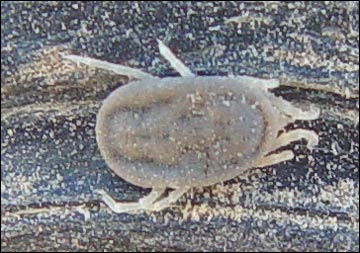 Ornithodorus turicata (dorsal view) on a Desert Tortoise (© 2007 S. Ferrand) |
Ticks are interesting creatures with complex life cycles. Unfortunately, they bite humans and suck our blood, creeping us out. It is hard to get past this fact, so it is fortunate that few ticks bother humans in the desert and mountains around Las Vegas. Soft Ticks (Family Argasidae) can be recognized by having mouth parts that are underneath the head and point down, and the exterior is entirely leathery. In contrast, Hard Ticks (Family Ixodidae) have mouth parts that extend forward from the head, and they have a hard dorsal shield on the upper back. |
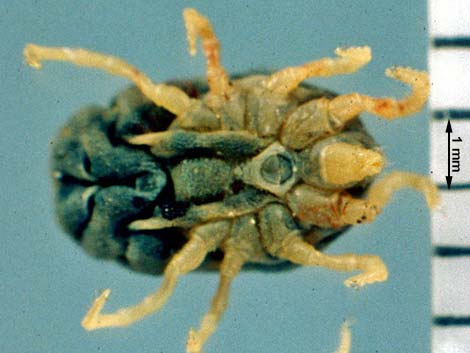 Ornithodorus turicata (ventral view). Photo by JL Occi. |
Soft ticks usually parasitize birds and mammals that use nests, providing a regular site for the ticks to feed and develop. Some species of birds change nests with every clutch to avoid ticks. Two species of Soft Ticks (Ornithodorus parkeri and Ornithodorus turicata) can be found on Desert Tortoises around Las Vegas. They live in tortoise burrows, sucking blood when the tortoises are home, and sometimes going for a ride to a new burrow. Oddly, these ticks suck tortoise blood from outside the shell. They crawl onto the back or the belly of the tortoise and insert their head between the scutes (shell pieces). Because they live in the nests and burrows of other animals, Soft Ticks are unlikely to feed on humans, but if they do, they can pass diseases quickly because they feed quickly (about 1 hour). In contrast, Hard Ticks may stay attached and feed for days. |
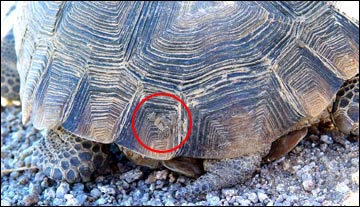 Typical position (red circle) on a Desert Tortoise (© 2007 S. Ferrand) |
The two species of Soft Ticks that commonly feed on Desert Tortoise can transmit bacterial spirochetes (Borrelia parkeri and Borrelia turicatae, respectively) that cause American Tickborne Relapsing Fever (TBRF) in humans. In these ticks, Borrelia spirochetes live in the salivary glands, and the spirochetes are quickly transmitted during feeding. TBRF causes recurring fevers separated by periods of non-fever, headaches, stomachaches, and general aches and pains. Diagnosing TBRF requires laboratory confirmation of spirochetes in the blood, but because it is rarely seen in southern Nevada, it would be worth telling your doctor that tick bites and related diseases are a possibility. Treatment with tetracycline antibiotic is effective. |
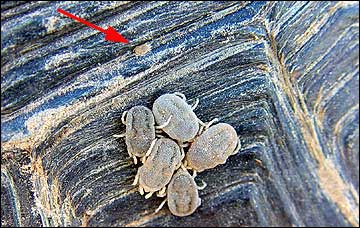 Group of Ornithodorus turicata ticks on a tortoise; notice the baby (red arrow) (© 2007 S. Ferrand) |
In the U.S., more than 450 cases of TBRF were reported between 1977 and 2000, mostly in Washington and northern Idaho, but a few cases were from the north rim of the Grand Canyon. TBRF commonly occurs after humans explore caves or crawl under buildings. Tortoise biologists might be exposed to this disease while excavating burrows or handling wild tortoises. |
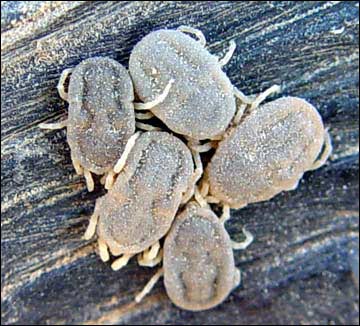 Same photo as above; close up (© 2007 S. Ferrand) |
The only place in southern Nevada where I know ticks to be a problem for humans is in the Arrow Canyon Range, where the Hard Tick Dermacentor hunteri seems to be fairly common. I've never seen a tick on a human at Red Rocks, Lake Mead, or Mt. Charleston, places that all have plenty of opportunities for ticks, although there has been at least one case of Lyme Disease on Mt. Charleston. |
Note: All distances, elevations, and other facts are approximate.
![]() ; Last updated 230811
; Last updated 230811
Return to All Ticks.
| Inverts Around Las Vegas | Wildlife Around Las Vegas | Glossary | Copyright, Conditions, Disclaimer | Home |